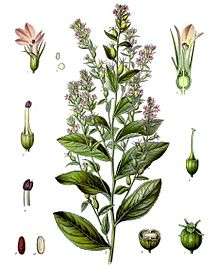Lobelia inflata
Lobelia inflata, also known as Indian tobacco or puke weed, is a species of Lobelia native to eastern North America, from southeastern Canada (Nova Scotia to southeast Ontario) south through the eastern United States to Alabama and west to Kansas.[2]
| Indian tobacco | |
|---|---|
 | |
| Lobelia inflata[1] | |
| Scientific classification | |
| Kingdom: | Plantae |
| Clade: | Tracheophytes |
| Clade: | Angiosperms |
| Clade: | Eudicots |
| Clade: | Asterids |
| Order: | Asterales |
| Family: | Campanulaceae |
| Genus: | Lobelia |
| Species: | L. inflata |
| Binomial name | |
| Lobelia inflata | |
Growth
Lobelia inflata is an annual or biennial herbaceous plant growing to 15–100 cm (5.9–39.4 in) tall, with stems covered in tiny hairs. Its leaves are usually about 8 cm (3.1 in) long, and are ovate and toothed. they are alternately arranged. It has violet flowers that are tinted yellow on the inside, and usually appear in mid-summer and continue to bloom into fall.[3] The seedcases are small, brown, dehiscent, and papery.[4]
Propagation
Propagation is usually accomplished by cuttings or seed. Seeds are sown in containers in mid spring or mid fall. The seeds take about 2 weeks to germinate.
Traditional uses
Lobelia inflata has a long use as a medicinal plant, as an entheogenic, emetic, and a dermatological and respiratory aid.[5] Native Americans used it for respiratory and muscle disorders, as a purgative, and as a ceremonial medicine.[5] The leaves were chewed and smoked.[6] The plant was used as a traditional medicinal plant by the Cherokee, Iroquois, Penobscot, and other indigenous peoples. The foliage was burned by the Cherokee as a natural insecticide, to smoke out gnats.[5] It was widely used in the pre-Columbian New England region, long before the time of Samuel Thomson, who was erroneously credited as discovering it.
It is still used medicinally in the present day;[7] however, there are adverse effects that limit its use.[8] Side effects can include sweating, nausea, vomiting, diarrhea, tremors, rapid heartbeat, mental confusion, convulsions, hypothermia, coma, and possibly death.[9]
The root is toxic and can be fatal if eaten.[6]
Chemical constituents
Lobelia inflata has been shown to contain 52 different alkaloid compounds,[10] the most studied and medically pertinent being lobeline.[11]
References
- Franz Eugen Köhler, 1897, Köhler's Medizinal-Pflanzen
- "Lobelia inflata". Germplasm Resources Information Network (GRIN). Agricultural Research Service (ARS), United States Department of Agriculture (USDA). Retrieved 2009-04-09.
- Caldecott, T. Western Materia Medica: Lobelia inflata (pdf file)
- "Some Call Them Weeds". 2016-01-02.
- University of Michigan at Dearborn: Native American Ethnobotany of Lobelia inflata
- Niering, William A.; Olmstead, Nancy C. (1985) [1979]. The Audubon Society Field Guide to North American Wildflowers, Eastern Region. Knopf. p. 441. ISBN 0-394-50432-1.
- "Lobelia". EBSCO Complementary and Alternative Medicine (CAM) Review Board. January 2006. Retrieved 2007-09-12.
- "Risky pills: Supplements to avoid". Consumer Reports. 73 (1): 46–7. 2008. PMID 18488285.
- "Lobelia". University of Maryland Medical Center.
It can cause serious side effects, such as profuse sweating, nausea, vomiting, diarrhea, tremors, rapid heartbeat, mental confusion, convulsions, hypothermia, coma, and possibly even death.
- Kursinszki, László; Szőke, Éva (2015). "HPLC-ESI-MS/MS of brain neurotransmitter modulator lobeline and related piperidine alkaloids in Lobelia inflataL". Journal of Mass Spectrometry. 50 (5): 727–33. doi:10.1002/jms.3581. PMID 26259655.
- "Taxon: Lobelia inflata L." National Plant Germplasm System.